#non sparking tool kit
Explore tagged Tumblr posts
Text
#striking wrench supplier#measuring instruments suppliers in dubai uae#non sparking tools in dubai uae#Brass hammer suppliers in dubai Uae#gauge block set supplier in Dubai uae#Helicoil Thread Repair Kits Suppliers in Dubai UAE
0 notes
Text
More on pre-electricity lighting.
Interesting to see this one pop up again after nearly two years - courtesy of @dduane, too! :->
*****
After experiencing a couple more storm-related power cuts since my original post, as well as a couple of after-dark garden BBQs, I've come to the conclusion that C.J. Cherryh puts far too much emphasis on "how dark things were pre-electric light".
For one thing eyes adjust, dilating in dim light to gather whatever illumination is available. Okay, if there's none, there's none - but if there's some, human eyes can make use of it, some better or just faster than others. They're the ones with "good night vision".
Think, for instance, of how little you can see of your unlit bedroom just after you've turned off the lights, and how much more of it you can see if you wake up a couple of hours later.
There's also that business of feeling your way around, risking breaking your neck etc. People get used to their surroundings and, after a while, can feel their way around a familiar location even in total darkness with a fair amount of confidence.
Problems arise when Things Aren't Where They Should Be (or when New Things Arrive) and is when most trips, stumbles, hacked shins and stubbed toes happen, but usually - Lego bricks and upturned UK plugs aside - non-light domestic navigation is incident-free.
*****
Here are a couple of pics from one of those BBQs: one candle and a firepit early on, then the candle, firepit and an oil lamp much later, all much more obvious than DD's iPad screen.


Though I remain surprised at how well my phonecam was handling this low light, my own unassisted eyes were doing far better. For instance, that area between the table and the firepit wasn't such an impenetrable pool of darkness as it appears in the photo.
I see (hah!) no reason why those same Accustomed Eyes would have any more difficulty with candles or oil lamps as interior lighting, even without the mirrors or reflectors in my previous post.
With those, and with white interior walls, things would be even brighter. There's a reason why so many reconstructed period buildings in Folk Museums etc. are (authentically) whitewashed not just outside but inside as well. It was cheap, had disinfectant qualities, and was a reflective surface. Win, win and win.
*****
All right, there were no switches to turn on a light. But there was no need for what C.J. describes as stumbling about to reach the fire, because there were tinderboxes and, for many centuries before them, flint and steel. Since "firesteels" have been heraldic charges since the 1100s, the actual tool must have been in use for even longer.
Tinderboxes were fire-starter sets with flint, steel and "tinder" all packed into (surprise!) a box. The tinder was easily lit ignition material, often "charcloth", fabric baked in an airtight jar or tin which would now start to glow just from a spark.
They're mentioned in both "The Hobbit" and "The Lord of the Rings". Oddly enough, "Hobbit" mentions matches in a couple of places, but I suspect that's a carry-over from when it was just a children's story, not part of the main Legendarium.
Tinderboxes could be simple, just a basic flint-and-steel kit with some tinder for the sparks to fall on...

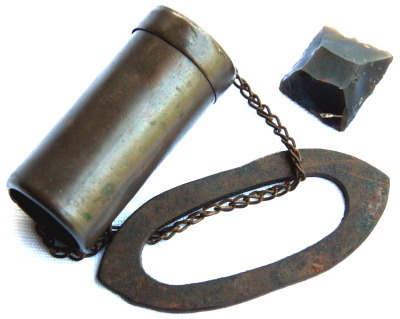

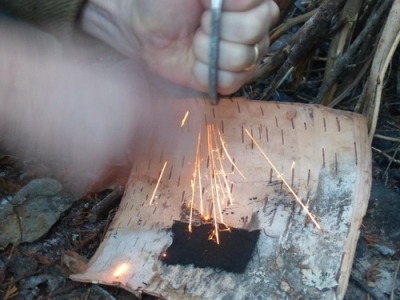
...or elaborate like this one, with a fancy striker, charcloth, kindling material and even wooden "spills" (long splinters) to transfer flame to a candle or the kindling...
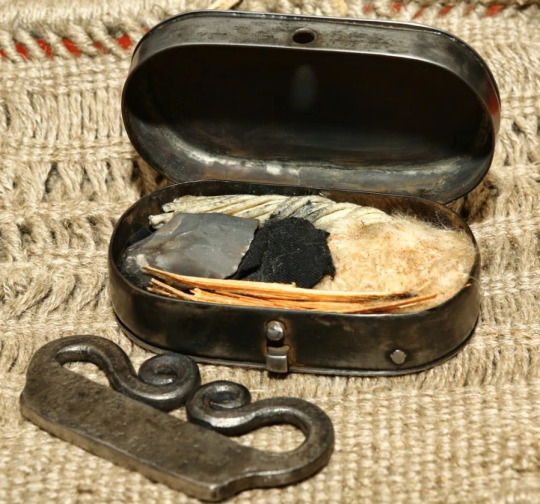
This tinderbox even doubles as a candlestick, complete with a snuffer which would have been inside along with everything else.

Here's a close-up of the striker box with its inner and outer lids open:

What looks like a short pencil with an eraser is actually the striker. A bit of tinder or charcloth would have been pulled through that small hole in the outer lid, which was then closed.
There was a rough steel surface on the lid, and the striker was scraped along it, like so:

This was done for a TV show or film, so the tinder was probably made more flammable with, possibly, lighter fuel. That would be thoroughly appropriate, since a Zippo or similar lighter works on exactly the same principle.
A real-life version of any tinderbox would usually just produce glowing embers needing blown on to make a flame, which is shown sometimes in movies - especially as a will-it-light-or-won't-it? tension build - but is usually a bit slow and non-visual for screen work.
*****
There were even flintlock tinderboxes which worked with the same mechanism as those on firearms. Here's a pocket version:
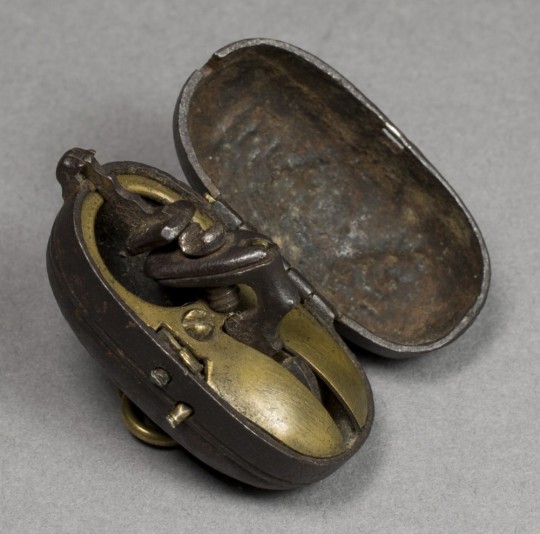
Here are a couple of bedside versions, once again complete with a candlestick:
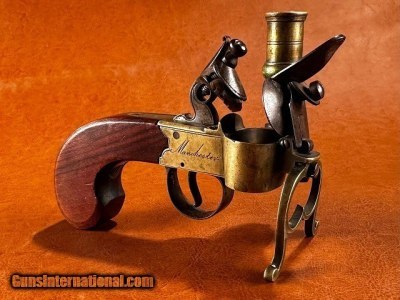
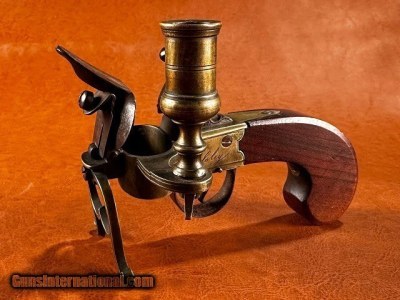
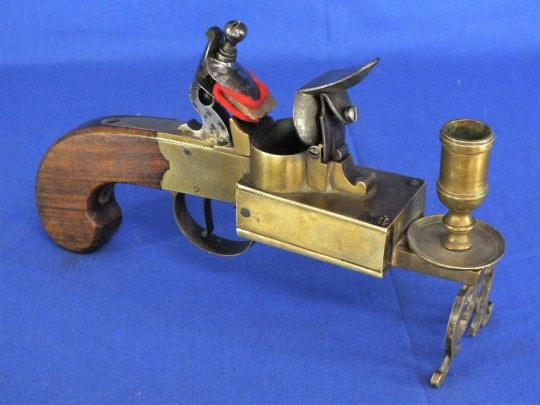
And here are three (for home defence?) with a spotlight candle lantern on one side and a double-trigger pistol on the other.

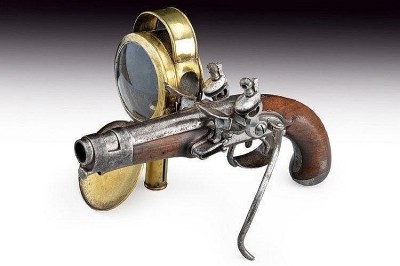
Pull one trigger to light the candle, pull the other trigger to fire the gun.

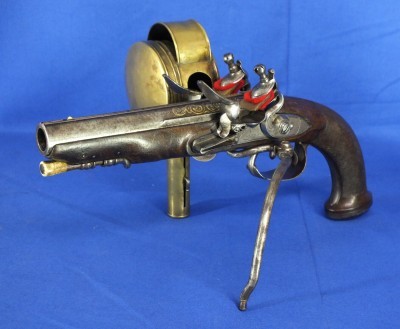
What could possibly go wrong? :-P
*****
Those pistol lanterns, magnified by lenses, weren't just to let their owner see what they were shooting at: they would also have dazzled whatever miscreant was sneaking around in the dark, irises dilated to make best use of available glimmer.
Swordsmen both good and bad knew this trick too, and various fight manuals taught how to manage a thumb-shuttered lamp encountered suddenly in a dark alley.
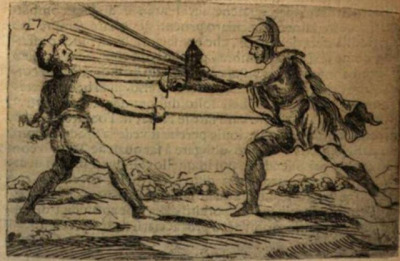
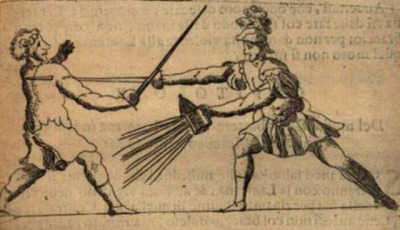
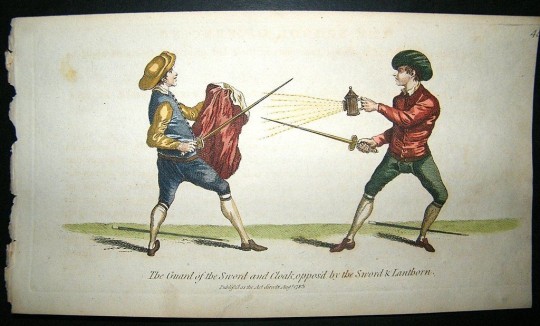
There's a sword-and-lantern combat in the 1973 "Three Musketeers" between Michael York (D'Artagnan) and Christopher Lee (Rochefort), which was a great idea.
Unfortunately it failed in execution because the "Hollywood Darkness" which let viewers see the action, wasn't dark enough to emphasise the hazards / advantages of snapping the lamps open and shut.
This TV screencap (can't get a better one, the DVD won't run in a computer drive) shows what I mean.
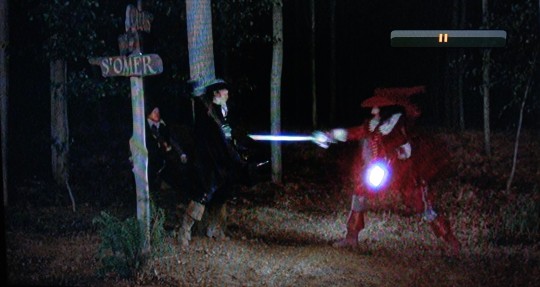
In fact, like the photos of the BBQ, this image - and entire fight - looks even brighter through "real eyes" than with the phonecam. Just as there can be too much dark in a night scene, there can also be too much light.
*****
One last thing I found when assembling pics for the post were Folding Candle-lanterns.
They were used from about the mid-1700s to the later 20th century (Swiss Army ca. 1978) as travel accessories and emergency equipment, and IMO - I've Made A Note - they'd fit right into a fantasy world whose tech level was able to make them.
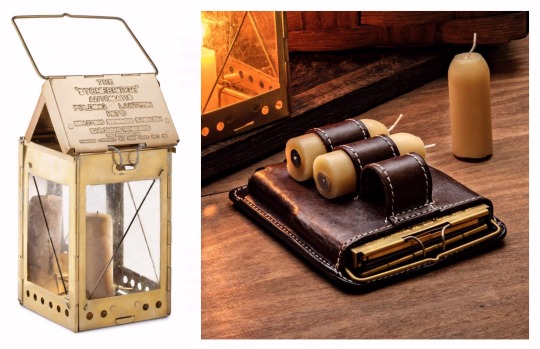
The first and last are reproductions: this one is real, from about 1830.
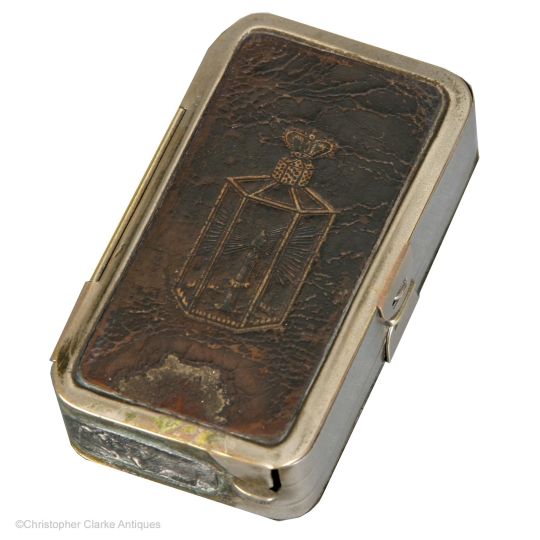
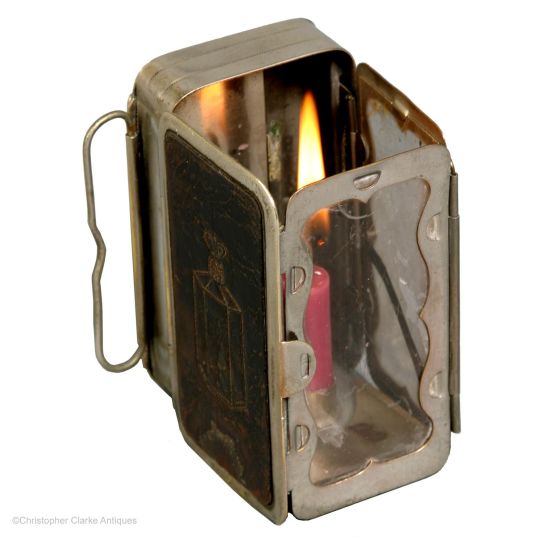
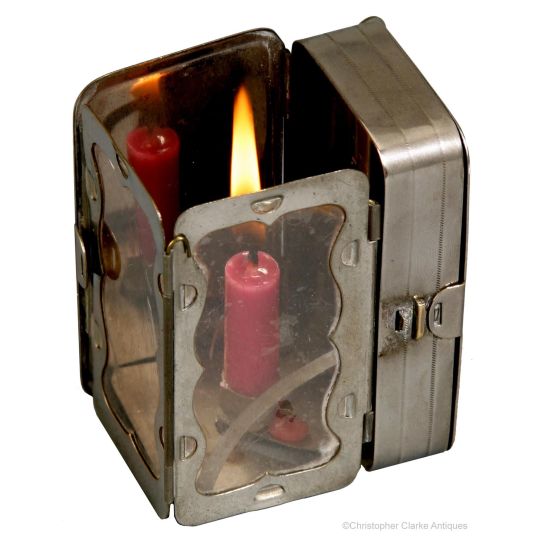
The clear part was mica - a transparent mineral which can be split into thin flexible sheets - while others use horn / parchment, though both of these are translucent rather than transparent. Regardless, all were far less likely to break than glass.
One or two inner surfaces were usually tin, giving the lantern its own built-in reflector, and tech-level-wise, tin as a shiny or decorative finish has been used since Roman times.
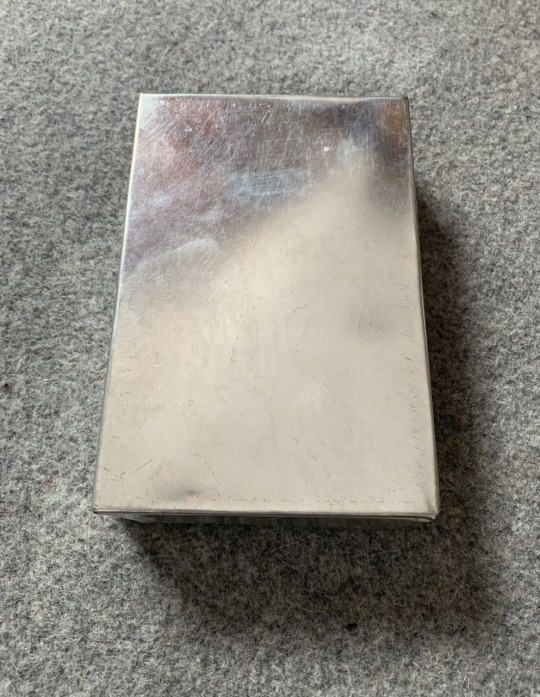

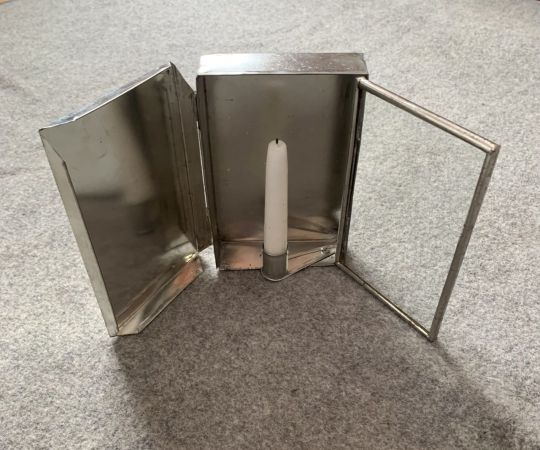

I'm pretty sure that top-of-the-line models could also have been finished with their own matching, maybe even built-in, tinderboxes.
And if real ones didn't, fictional ones certainly could. :->
*****
Yet more period lighting stuff here, including flintlock alarm clocks (!)
#period lighting#tinderbox#too light too dark#social history#writer notes#research#period tech#sword vs lantern#c. j. cherryh
2K notes
·
View notes
Text
Meeting Music
Okay so this is a (quite short) fic involving @cuppajj ‘s wonderful OC Drillburst, and my own OC Pillar.
When it comes to writing with another person’s OC, I do my best to get into contact with their creator. And Cuppa has been amazing with that! Still, regardless, any mistakes are completely my own.
Arriving back on Cybertron following the end of the war was different for every mech. That much was to be expected. Being that the Autobots had “won,” arriving in the company of two former Decepticons made things a touch more complicated. Iona, for her part, kept up her air of apathetic arrogance. Ace asked what was going on about halfway through each new vetting process; all these new faceplates and designations did no wonders on his already fragile comprehension. Pillar tried to manage both his comrades’ aggression and confusion the best way he knew how - by being present. He insisted that for every interview, every test, every licensing exam, he needed to be in the room. He wasn’t about to let two of the few good sparks he had left be screwed over by the new-age society that wasn’t as righteous and non-judgemental as it proclaimed itself to be.
This meant, by the end of the whole thing, Pillar was absolutely exhausted. he didn’t like socializing at the best of times. Two friends he could handle - he’d been stuck out in space with them, on a tiny shuttle, for Primus-knew-how-long. But all of the red tape and hoop jumping wore his people-skills to a thin line. When he snapped at Iona to “just buff her chassis herself” (which had been received with a mild raise of an optical ridge) Pillar knew he needed to get out on his own again. Murmuring an apology, Pillar quickly excused himself and retreated from the room, grabbed his tool kit, and transformed to race off down the unfamiliar streetways.
After some wandering, and realizing he recognized absolutely nothing, Pillar resigned himself to peaking his helm into random places until he found something suitable. He needed a smaller place, without too-boisterous of an atmosphere, and a good corner to hide away in. There was no way he’d be able to find a mech-less place in this city. But the fewer, the better.
He discovered his space for the off-cycle in a smaller, quieter bar. The moment his green optics peered inside and found a mix of Decepticons, Autobots, and even NAILs, Pillar felt a bit more at ease. Maybe, if he ever felt like risking the company, he might even bring Iona and Ace here. His entrance went unnoticed. To his surprise, and appreciation, Pillar noted more easily-accessible seating scattered throughout the main floor. It felt nice not to have to hop a bit to get into a seat.
There was no server that he could locate which suited him fine. Strangely enough, he didn’t feel like drinking this time around. Instead he pulled out his latest project and began fiddling with the wiring. His Primus-given helmlight was barely noticeable in the brighter bar. However, as the breems ticked by, Pillar failed to notice the dimming lights. That is until the surrounding mecha cleared their exhausts, startling the ex-miner from his reverie. Embarrassed, Pillar immediately snuffed his lights, even going so far as to dim the natural biolights crossing his chassis. Though it pained him to do so, Pillar extended his EM field, pushing apology to the forefront. Satisfied, nearby patrons shifted in their seats to focus ahead on the still-lit stage.
Pillar immediately stiffened in his seat, wondering how he could have missed something like this. (He knew how, he once again got caught up in his work and the world around ceased to exist/matter.) Checking the bar’s available public feed, Pillar quickly learned that there were apparently regular performances from local artists hosted at the establishment. That didn’t sound like his preferred space. He liked lights-on, quiet places, somewhere he could work without being disturbed too much by outside presence.
With his biolights still dimmed, Pillar quietly shifted out of his seat and made his way towards the exit. He made sure to weave around tables seating regular-sized Cybertronians, to avoid further humiliation of having to crouch. By this point, a large - scratch that huge mech stepped up onto the stage. That in itself might have given Pillar some pause. It was the mech’s design that actually made him stop.
They were almost entirely green in color, with massive column-treads over either shoulder. The continuation of treads along their pauldron-armor and legs spoke to a tank or similar alt-mode. That stopped at the drill halves situated over, almost shielding, the arms. This mech had to have been a miner before the War. And yet they did not wear a Decepticon crest, to Pillar’s surprise and growing respect. But it was a strange symbol, black and jagged. It looked most similar to an odd organic skull.
The mech paused on stage, seemingly waiting for some unknown que. His visor grew shadowed even in the only remaining halo of light. Then he began to hum.
The sound, amplified by the combination of speakers and the mech's own electro-bass, shook through the stage and down into the flooring. Pillar might find the tables trembling if he were inclined to turn his optics from the stage. Not long into those first few powerful notes, the mech raised a pede and lightly struck the stage. It didn't take long for bar patrons to join the beat. Pillar, despite himself, took to knocking one servo against his plating.
Pillar remembered this song. They sang a similar version back in the mines of Luna 2. And that brought a whole slew of unwanted information recalls to his processor. He had buried most with a reason. But he still found himself whispering along to those lyrics in the bid of a forgotten self.
It’s dark as a dungeon,
And damp as the dew.
Where the danger is double
And pleasures are few
Where the rain never falls
And the sun never shines.
It’s dark as a dungeon
Way down in the mines.
The miners kept time in their swings. And the mechs like Pillar stayed out of their way. But he still found himself singing when one would eventually demand he help haul. A technician solely in function title - at the end of the cycle, he'd still been made to pick up the slack. And there was always, always more work to be done.
The mech's field pushed a somber, melancholy feeling into the crowd. It was slow to come and gently flowing. And Pillar recognized it was echoed by many of the other patrons. Most seemed to be lost, like the performer, like himself, in darker thoughts. Darker thoughts, and darker spaces still. Places lit only by crystalline lamps if you were lucky, and your own lights if not. The smell of a new vein to promise success, calling them deeper. The sensation of shavings grinding inside pumps and vents, never rid of the past.
But, like a tide of oil, the performer's tone changed. His field gained a softer, almost hopeful, feeling, and weight seemed to lift from his shoulders. He sang lyrics Pillar had never heard, even in all the different versions he'd run across.
Though I carry my scars
And feeling’s still new
And I pick through the rubble
And I’m most of’n blue
I’ll walk down the halls
And meet all new kinds
I’m ‘way from the dungeon
Way down in the mines.
Now the mech was looking up, away from the stage, and passing the ceiling. Something different graced his strong features; a small quirk of lip components in what Pillar could almost call a smile. The bar had grown quiet by then, all listening, watching. And someone started to clap. Then everyone was clapping, some even whooping their praise.
And their performer looked at his audience for the first time that cycle. The small smile was bigger, more sincere, and confident. He returned to his performance with renewed vigor, earlier mood appearing forgotten, and the cheering crowd grew softer.
Pillar stayed for the mech's entire performance. And though not all of the songs appealed to him, he still found himself enjoying the atmosphere they created. For the first time in a long time, he felt relaxed.
Drillburst of Velux (according to the information feed) played and sang for them, and for himself. As the set continued, his confidence grew. He still looked haunted, to Pillar's optics, but this was a break afforded by indulging in post-war freedoms. A miner performing on stage - far, far away from the deadly tunnels; a miracle from function.
Pillar returned to his shared apartment at the end of the cycle. It was around the time for another appointment with the newly founded "Reparation and Renewal" agency. Iona didn't say much, aside from a snarky comment on "behaving the better 'bot," which Pillar dutifully chuffed at. He was smiling part way through - something Ace seemed astounded by and loudly pointed out.
“I want to show you guys something.”
#transformers#Transformers MTMTE#not my oc#transformers oc#one is and isn't mine#My writing#I'm sorry it's not longer#Pillar
24 notes
·
View notes
Text
Fun and Essential Items for Your Little One’s Growth
Encouraging Creativity with a Finger Painting Kit for Kids Art plays a vital role in a child’s development, and introducing them to colors and textures at an early age sparks creativity. A Finger Painting Kit for Kids allows little ones to explore their artistic side while improving their motor skills. These kits come with non-toxic paints that are safe for children, ensuring they can freely express their imagination without worry.
Using a finger painting kit also fosters sensory development, as children engage in a tactile experience by feeling the paint on their fingertips. Additionally, painting activities help improve hand-eye coordination and concentration. Whether creating abstract designs or simple shapes, every stroke contributes to a child’s cognitive and emotional growth. Parents can make the activity even more exciting by encouraging storytelling through art, helping kids build their communication skills from an early age.
A Guide on Best Stroller for Baby: Ensuring Comfort and Safety Choosing the right stroller is one of the most important decisions for new parents. With numerous options available, a Guide on Best Stroller for Baby helps navigate through different features to find the perfect fit. A good stroller should provide safety, convenience, and comfort for both the baby and the parents.
Lightweight strollers are ideal for parents who are always on the move, as they are easy to fold and carry. For those who love jogging or outdoor adventures, all-terrain strollers with sturdy wheels and suspension systems ensure a smooth ride. Features such as adjustable seats, sun canopies, and ample storage space add to the overall functionality. Investing in the right stroller guarantees a hassle-free experience while keeping the baby secure during travels.
Enhancing Security with a Baby Monitor for Your Little One Ensuring a baby’s safety is a top priority for every parent, and a Baby Monitor for Your Little One provides peace of mind. Modern baby monitors offer advanced features such as video surveillance, temperature detection, and two-way communication, allowing parents to keep an eye on their child at all times.
With a high-quality baby monitor, parents can check on their little one without disturbing their sleep. Some models even come with night vision technology, ensuring clear visibility in low-light conditions. Whether in another room or away from home, a reliable baby monitor helps parents feel connected and reassured about their baby’s well-being.
Musical Fun with Guitar Toys for Kids Introducing music to children at an early age enhances their cognitive skills and creativity. Guitar Toys for Kids provide a fun and engaging way to develop an interest in music. These toy guitars are designed to be child-friendly, with vibrant colors, easy-to-press buttons, and pre-recorded melodies that make learning enjoyable.
Playing with a toy guitar improves hand coordination and rhythm, helping children develop essential skills that benefit them in the long run. Some models even allow kids to create their own tunes, encouraging them to experiment with sounds and express themselves through music. A toy guitar can also be a great bonding tool between parents and children, as they can sing and play along together, making cherished memories.
Every child’s development journey is unique, and selecting the right tools and toys enhances their growth in different ways. A Finger Painting Kit for Kids fosters creativity and fine motor skills, while a Guide on Best Stroller for Baby helps parents make informed decisions for their child’s comfort. Ensuring safety with a Baby Monitor for Your Little One offers peace of mind, and Guitar Toys for Kids provide an exciting introduction to music. Investing in these items enriches a child’s early years, laying the foundation for a bright and happy future.
1 note
·
View note
Text
Choosing the Perfect Toy: How to Select the Best Learning Toys for Your Child
As parents, one of the most important decisions you make is choosing the right toys for your children. Toys are not only a source of entertainment, but they also provide opportunities for learning, development, and creativity. With so many options available, how do you ensure that the toys you choose will help your child grow, learn, and thrive?
At My Gigi's Place, the leading kids toys online store in the USA, you’ll find a wide selection of toys that not only entertain but also stimulate your child's mind and foster their development. Here's a guide to help you choose the best learning toys for your child.
Why Choose Learning Toys?
Learning toys are essential because they combine fun and education, offering children valuable opportunities to grow and develop in several key areas:
Cognitive Skills Toys like puzzles, building blocks, and STEM kits help children sharpen their critical thinking, memory, and problem-solving skills. These toys encourage logical reasoning and creativity while helping kids understand cause-and-effect relationships.
Social and Emotional Development Many educational toys encourage cooperative play, helping children learn how to communicate, share, and collaborate with others. This type of play fosters empathy, patience, and understanding, all of which are critical for emotional development.
Motor Skills Toys that involve fine or gross motor skills—such as shape sorters, art supplies, and sports gear—help children develop their coordination and dexterity. Fine motor skills are vital for writing, drawing, and everyday activities, while gross motor skills improve balance, strength, and physical awareness.
Language Skills Books, interactive toys, and games that focus on language development help improve vocabulary, pronunciation, and understanding of words and concepts. These toys give children the tools they need to communicate more effectively, preparing them for reading and writing.
Creativity and Imagination Open-ended toys, such as art supplies, musical instruments, and dress-up sets, spark imagination and creativity. They allow children to express themselves, create stories, and build their own worlds, which is important for their cognitive and emotional growth.
How to Choose the Right Learning Toy for Your Child
When shopping for learning toys, there are several factors to consider. Here are some tips to help you make the best choice:
Age Appropriateness Choose toys that are designed for your child’s developmental stage. Toys that are too advanced may frustrate your child, while toys that are too simple may not provide enough stimulation. Look for age recommendations and guidelines on packaging to find toys that suit your child’s abilities.
Educational Value Focus on toys that promote learning in various areas—cognitive, emotional, social, physical, and creative development. Whether it’s a building set that encourages problem-solving or an art kit that fosters creative expression, make sure the toy provides educational benefits beyond just entertainment.
Safety and Quality Safety is always a priority. Choose toys from reputable brands like My Gigi's Place, which ensures that every product is made with non-toxic materials, is durable, and meets safety standards. High-quality toys not only last longer but also provide a better overall experience for your child.
Variety of Play Options The best learning toys are those that provide multiple ways to play. For example, a set of building blocks can be used to build structures, learn about colors and shapes, or practice counting. Look for toys that grow with your child, offering new ways to play as their abilities develop.
Engagement and Interaction Interactive toys, such as those that feature sounds, lights, or responsive actions, can captivate a child’s attention and encourage active participation. These toys help with sensory development and keep children engaged in play, which is key for learning.
Why Shop at My Gigi’s Place – A Leading Kids Toys Online Store in the USA
If you’re on the hunt for high-quality, educational toys for your child, My Gigi's Place is the place to shop. As one of the best kids toys online stores in the USA, it offers an extensive selection of toys that help nurture every aspect of your child’s development. Here’s why My Gigi’s Place is your go-to destination for learning toys:
Wide Range of Educational Toys My Gigi's Place offers a diverse selection of toys that promote learning across all areas of development, from STEM toys and art supplies to musical instruments and outdoor play gear.
Trusted Brands and Quality Products All the toys at My Gigi's Place come from reputable brands known for producing safe and durable products. Parents can feel confident knowing that the toys they buy meet the highest safety standards.
Convenience and Customer Service Shopping online at My Gigi's Place is easy and convenient. You can browse through categories such as age groups, educational value, and toy types to find exactly what you need. Plus, their customer service team is always ready to help with any inquiries.
Great Deals and Discounts On top of offering a wide variety of toys, My Gigi’s Place provides exclusive deals and discounts, so you can shop for high-quality learning toys at affordable prices. Be sure to sign up for their newsletter to stay updated on promotions and special offers.
Top Learning Toys to Buy for Your Child
Here are some of the top learning toys available at My Gigi's Place:
Building and Construction Toys These toys help children develop problem-solving skills, spatial awareness, and creativity. Popular options include wooden blocks, LEGO sets, and STEM-based building kits that let kids experiment with design and engineering.
Interactive Books and Puzzles Books with textures, sounds, and interactive features engage children and promote language development. Puzzles, from simple ones for toddlers to more challenging options for older children, encourage problem-solving and cognitive development.
Musical Instruments Instruments like drums, xylophones, and keyboards introduce children to the world of music, helping them develop rhythm, coordination, and auditory skills. They also foster creativity and self-expression.
Art and Craft Kits These kits encourage creativity and fine motor skills. With options ranging from coloring books and paints to jewelry-making kits and clay modeling sets, there’s no limit to the fun and learning your child can experience.
Outdoor Toys for Physical Development Toys like scooters, bicycles, and outdoor playsets help kids stay active and improve their physical coordination. These toys are a great way to encourage outdoor play and boost overall health.
Conclusion
Choosing the perfect learning toys for your child doesn’t have to be difficult. By focusing on toys that stimulate creativity, critical thinking, and physical development, you can ensure your child’s growth while keeping them entertained. My Gigi's Place, your trusted kids toys online store in the USA, has everything you need to provide your child with the best educational toys available. With their vast selection, high-quality products, and excellent customer service, you’re sure to find the perfect toy to support your child’s development.
0 notes
Text
Essential Safety Equipment Every Construction Site Should Have
Introduction
Construction sites are inherently hazardous, with risks ranging from falling objects and electrical hazards to heavy machinery accidents. Ensuring worker safety is not just a legal requirement but also a moral responsibility for contractors, project managers, and site supervisors. The right safety equipment can prevent injuries, reduce downtime, and improve overall productivity.
In this guide, we’ll cover the essential safety equipment every construction site must have, along with tips on how to select high-quality gear. If you’re looking for reliable safety equipment and construction tools, visit AHM Building Materials for a wide range of industry-approved products.
1. Personal Protective Equipment (PPE): The First Line of Defense
Every worker on a construction site should be equipped with Personal Protective Equipment (PPE) to reduce the risk of injuries. PPE acts as a barrier against common construction hazards, including falling objects, sharp tools, and airborne debris.
✔ Essential PPE for Construction Workers:
Hard Hats: Protect against head injuries from falling objects.
Safety Glasses & Face Shields: Prevent eye injuries from dust, sparks, and flying debris.
High-Visibility Clothing: Enhances visibility to avoid accidents with vehicles and machinery.
Work Gloves: Provide grip, protection from sharp objects, and chemical resistance.
Steel-Toed Boots: Protect feet from heavy objects and punctures.
Respiratory Masks: Essential for jobs that involve dust, chemicals, or poor air quality.
Wearing proper PPE reduces workplace injuries significantly, making it a non-negotiable safety requirement on every site.
2. Fall Protection Gear: Preventing Accidents at Heights
Falls are one of the leading causes of fatalities on construction sites. Proper fall protection systems are crucial for ensuring worker safety, especially when working at elevated heights.
✔ Must-Have Fall Protection Equipment:
Safety Harnesses & Lanyards: Secure workers when working at heights.
Guardrails & Safety Netting: Provide additional protection on scaffolding and high structures.
Anchor Points & Lifelines: Essential for maintaining stability when working on roofs or tall buildings.
Ladders & Scaffolding Safety: Using certified ladders and properly assembled scaffolding reduces fall risks.
Employers must train workers on how to use fall protection equipment properly to prevent tragic accidents.
3. Fire Safety Equipment: Protecting Workers and Property
Construction sites involve electrical work, welding, and flammable materials, all of which pose fire hazards. Being prepared with fire safety equipment can prevent catastrophic damage.
✔ Essential Fire Safety Equipment:
Fire Extinguishers: Must be placed in accessible locations around the site.
Fire Blankets: Useful for putting out small fires on clothing or equipment.
Smoke Detectors: Provide early warnings of fire outbreaks.
Emergency Exit Plans: Clear escape routes and fire evacuation drills should be implemented.
Regular fire safety training and drills can save lives and minimize damage during emergencies.
4. First Aid Kits: Handling Emergencies Effectively
Accidents can happen anytime, making first aid kits a vital part of any construction site. A well-stocked first aid kit allows quick response to minor injuries, preventing them from becoming serious.
✔ Essential First Aid Supplies:
Bandages and Gauze Pads: For treating cuts and wounds.
Antiseptic Wipes & Disinfectants: Prevent infections from open wounds.
Burn Creams & Cold Packs: Provide relief for burns and swelling.
CPR Mask & Gloves: Essential for emergency resuscitation.
Every construction site should have designated first aid personnel trained to provide immediate assistance.
5. Electrical Safety Equipment: Reducing the Risk of Shocks and Fires
Construction sites often have exposed wiring, power tools, and heavy electrical loads, increasing the risk of electrocution. Ensuring electrical safety is critical to protecting workers.
✔ Essential Electrical Safety Equipment:
Insulated Gloves & Boots: Prevent electrical shock when handling wiring.
Circuit Breakers & Ground Fault Interrupters (GFCIs): Reduce the risk of electrical fires and short circuits.
Lockout/Tagout Kits: Prevent accidental activation of electrical systems during maintenance.
Voltage Testers & Insulation Tools: Ensure electrical systems are properly grounded and safe to work on.
Proper training in electrical safety protocols is crucial for preventing workplace injuries.
6. Heavy Equipment Safety: Reducing Machine-Related Accidents
Operating heavy-duty lifting equipment, cranes, forklifts, and other machinery requires strict safety protocols. Accidents involving heavy equipment can be devastating, making proper training and safety gear essential.
✔ Heavy Equipment Safety Essentials:
Seatbelts & Rollover Protection: Prevent injuries in case of machinery tipping over.
Backup Alarms & Signal Lights: Warn other workers when machinery is in operation.
Reflective Markings & Barricades: Ensure work zones are clearly marked to prevent collisions.
Hearing Protection (Earplugs/Earmuffs): Reduces noise exposure from loud machinery.
Regular safety inspections of machinery help identify potential issues before accidents occur.
7. Site Security & Emergency Communication Systems
Construction sites are prone to theft, vandalism, and unauthorized entry. Implementing security measures protects workers, equipment, and materials.
✔ Site Security Essentials:
Surveillance Cameras & Motion Sensors: Monitor activity and deter theft.
Fencing & Warning Signs: Restrict unauthorized access to hazardous areas.
Two-Way Radios & Emergency Alarms: Ensure quick communication in case of an emergency.
Emergency Assembly Points: Clearly marked locations for safe evacuation.
Having an emergency response plan ensures quick and effective action during accidents or security threats.
Where to Buy High-Quality Safety Equipment for Construction Sites?
Investing in high-quality safety gear can significantly reduce workplace accidents and improve efficiency. When looking for reliable safety equipment, it’s essential to buy from trusted suppliers.
At AHM Building Materials, you’ll find a wide range of safety gear and construction tools, including:
✔ Personal Protective Equipment (PPE) ✔ Fall Protection Systems ✔ First Aid Kits & Fire Safety Equipment ✔ Heavy-Duty Safety Gear for Machinery Operators ✔ Electrical Safety Tools
Visit AHM Building Materials to explore top-quality safety equipment at competitive prices.
Conclusion
Ensuring worker safety on a construction site requires proper planning, training, and high-quality equipment. From PPE and fire safety tools to fall protection and emergency communication systems, each element plays a crucial role in minimizing risks and protecting workers.
For premium safety gear and construction supplies, check out AHM Building Materials and equip your site with the best protection available.
0 notes
Text
Turn Your School into an Innovation Hub with a STEM Lab!

Introduction: A School Transformed
Principal Reynolds always dreamed of turning Lincoln High School into a center for innovation. But engagement in science and math was declining, and students weren’t excited about learning.
That all changed when the school introduced a STEM lab. Suddenly, students were designing solar-powered vehicles, coding AI programs, and 3D-printing prototypes. Within a year, participation in STEM courses increased by 40%, and math and science scores improved by 25%.
This transformation isn’t unique. Across the country, STEM labs are revolutionizing education, preparing students for the future and turning schools into innovation hubs. Want to do the same? Let’s explore how!
Why STEM Labs Are Game-Changers for Schools
1. Hands-On Learning Improves Knowledge Retention
Research by the National Training Laboratories found that students retain: 75% of knowledge through hands-on learning 50% through discussions Only 10% through lectures
STEM labs provide experiential learning—students build, test, and experiment, making concepts more tangible and boosting comprehension.
2. STEM Labs Spark Creativity & Innovation
A study by MIT found that students in hands-on STEM programs were 30% more likely to develop creative problem-solving skills.
Example: A school in Texas built a robotics team through their STEM lab. The students won a statewide competition, attracting partnerships with local tech companies and securing $100,000 in funding.
Encourages creative problem-solving Supports interdisciplinary learning Prepares students for real-world challenges
3. Prepares Students for High-Demand Careers
According to the U.S. Bureau of Labor Statistics:
STEM jobs are growing twice as fast as other careers.
STEM workers earn 26% more than non-STEM workers.
Top STEM Careers Include: AI & Robotics – Machine learning, automation, space exploration Software Development – Coding, cybersecurity, game design Biotech & Health Sciences – Biomedical engineering, pharmaceuticals
A STEM lab equips students with critical 21st-century skills, making them job-ready and competitive in the workforce.
4. Boosts Student Engagement & Performance
A Johns Hopkins University study found that students in active STEM programs experienced: 17% improvement in science & math scores 12% better analytical skills Increased problem-solving ability in all subjects
Example: A school in California saw a 30% rise in student attendance after introducing a STEM lab, as students were excited to learn.
How to Build a STEM Lab in Your School
1. Secure STEM Grants & Funding
Funding sources include:
National Science Foundation (NSF) – Funds STEM initiatives in schools
NASA & Google Education Grants – Supports STEM learning
Local Tech Partnerships – Companies donate STEM kits & resources
Example: A rural school in Georgia received a $75,000 grant from NSF to build a robotics lab, leading to a 50% increase in STEM enrollment.
2. Partner with Tech Companies & Universities
Many organizations offer: Free STEM software & hardware (Intel, Microsoft, Google) Mentorship & internship programs Industry-led workshops & hackathons
Example: Tesla partnered with Nevada schools to introduce engineering projects, leading to a 35% increase in students pursuing STEM degrees.
3. Choose Budget-Friendly STEM Tools
Affordable STEM kits include:
Raspberry Pi & Arduino – Coding & electronics projects
LEGO Mindstorms & VEX Robotics – Engineering & robotics
Tinkercad & 3D Printers – Prototyping & product design
Tip: Many STEM kits come with free teacher guides & lesson plans!
4. Train Teachers in STEM Education
Professional Development Resources:
Code.org & STEM.org – Free STEM training for teachers
MIT OpenCourseWare – Advanced STEM teaching resources
Coursera & edX – Online courses on STEM teaching strategies
A report by Education Week found that well-trained STEM teachers improve student performance by 22%.
Ready to Turn Your School into an Innovation Hub?
A STEM lab isn’t just a classroom upgrade—it’s a launchpad for future innovators! Schools with STEM labs see higher student engagement, improved academic performance, and better career readiness. Now is the time to act! Whether you’re an educator, administrator, or parent, advocating for STEM education can change lives. Start building a STEM lab in your school today and inspire the next generation of innovators!
CTAs for Schools & Educators:
Take the first step toward transforming your school apply for STEM funding today! Empower your students with cutting-edge technology! Find the best STEM resources for your school. Want to boost student engagement and academic success? Start your STEM lab today!
Don’t wait start building a STEM lab in your school today!
Contact Maker Muse today !
Website: https://makersmuse.in/ Email: [email protected]
0 notes
Text
Java Runtime License: Is Java Free?
Java is one of the most widely used programming languages and platforms, powering billions of devices worldwide. Developers rely on Java for its versatility, compatibility, and robustness. However, with Oracle's licensing changes over the years, one critical question arises: Is Java free? This inquiry often centers around the Java Runtime License, which governs the usage of Java Runtime Environment (JRE) and other Java-related tools.
Understanding the licensing landscape is crucial for developers, businesses, and organizations that depend on Java for software development, deployment, or operations. Missteps in licensing compliance could lead to unexpected costs or legal complications. To clarify the confusion, let’s delve into the specifics of the Java Runtime License and whether Java remains free to use.
What Is the Java Runtime Environment (JRE)?
The Java Runtime Environment is essential for running Java-based applications. It includes the Java Virtual Machine (JVM), core libraries, and additional tools necessary to execute Java programs. Many applications—ranging from enterprise software to web-based tools and consumer apps—require the JRE to function.

Historically, the JRE was freely available under Sun Microsystems’ open licensing model. After Oracle acquired Sun Microsystems in 2010, the company introduced significant changes to Java’s licensing, sparking debates about whether Java is still free.
Is Java Free to Use?
The answer depends on the specific version and distribution of Java you choose to use. Oracle provides both free and paid options, and understanding these distinctions is key to avoiding licensing pitfalls.
Oracle JDK vs. OpenJDK The most significant distinction in licensing revolves around the Oracle JDK (Java Development Kit) and OpenJDK.
Oracle JDK: This version includes commercial features and long-term support. Oracle now requires a subscription for using Oracle JDK in production environments after the trial period ends.
OpenJDK: OpenJDK is an open-source implementation of Java, governed by the GNU General Public License (GPL). It is free to use, but it may lack some of the advanced features and support offered by Oracle JDK.
Free for Personal and Development Use Under the terms of Oracle’s Java Runtime License, Java remains free for personal use, development, and testing. If you are a developer working on non-commercial projects or running Java for personal purposes, you can use Oracle JDK without incurring costs. However, deploying Java in production environments often requires a paid license.
Licensing for Commercial Use For businesses and organizations, the Java Runtime License is not always free. Commercial deployments using Oracle JDK typically require a subscription. Costs depend on the number of users, processors, and instances of Java in use.
Changes in Oracle's Java Licensing Model
Oracle’s licensing model has undergone several iterations. Notably, in 2019, Oracle transitioned to a subscription-based model for its Oracle JDK. This change required businesses to pay for Java usage in production environments unless they opted for OpenJDK or other free alternatives.
Another major update came in 2023, with the release of the Oracle No-Fee Terms and Conditions (NFTC) license. Under this license, specific versions of Oracle JDK are free to use in production, provided they are not updated to newer versions beyond the specified release window. Businesses must carefully evaluate whether this arrangement aligns with their needs.
Free Alternatives to Oracle JDK
To avoid the complexities of the Java Runtime License, many organizations explore free alternatives to Oracle JDK. Some popular options include:
OpenJDK: The official open-source version of Java maintained by Oracle and the Java community.
Amazon Corretto: A free, production-ready distribution of OpenJDK provided by Amazon Web Services (AWS).
Adoptium (formerly AdoptOpenJDK): A free OpenJDK distribution supported by the Eclipse Foundation.
Zulu by Azul Systems: A certified, free-to-use OpenJDK distribution with additional enterprise-grade support options.
These alternatives are free for most use cases, including commercial deployments, and can serve as a viable substitute for Oracle JDK.
Compliance and Risks of Ignoring the Java Runtime License
Ignoring the licensing requirements of the Java Runtime License can lead to compliance issues and unexpected costs. Oracle conducts regular audits to ensure organizations adhere to licensing terms. Non-compliance could result in financial penalties, legal disputes, and reputational damage.

To mitigate these risks, organizations should:
Understand their usage: Conduct an internal audit to determine how Java is used across applications and environments.
Choose the right distribution: Evaluate whether Oracle JDK, OpenJDK, or a free alternative best suits their needs.
Stay informed: Keep up with Oracle’s licensing updates and ensure compliance with new terms and conditions.
Is Java Still Worth It?
Despite the licensing challenges, Java remains a powerful and reliable platform. Its extensive ecosystem, cross-platform compatibility, and widespread adoption make it indispensable for many organizations. The availability of free alternatives like OpenJDK ensures that Java continues to be accessible to developers and businesses of all sizes.
For those asking, “Is Java free?”, the answer lies in the specific context of usage. While free options exist, organizations must carefully navigate the Java Runtime License to ensure compliance and avoid unexpected costs.
By understanding Oracle’s licensing policies and exploring alternative distributions, developers and businesses can continue to leverage Java’s capabilities without compromising their budget or legal standing.
0 notes
Text
Top Learning Toys for Kids That Spark Creativity and Fun
In today’s fast-paced digital age, finding the perfect balance between fun and learning for kids can be challenging. Thankfully, learning toys offer a way to make education engaging and exciting. Let’s dive into some of the best options that not only entertain but also educate.

The Role of Learning Toys in Child Development
Why Learning Toys Are Essential
Enhancing Cognitive Skills
Learning toys are designed to stimulate children’s brains. Puzzles, for instance, improve problem-solving abilities, while memory games enhance concentration and focus.
Encouraging Imaginative Play
Pretend play sets like kitchen toys or superhero costumes let kids unleash their imaginations. They create stories, explore scenarios, and develop a sense of empathy as they pretend to step into someone else’s shoes.
Balancing Fun and Education
The best learning toys strike the perfect balance—they’re fun enough to captivate kids’ attention and educational enough to make an impact on their development.
Benefits of Learning Toys That Spark Creativity
Building Problem-Solving Skills
Toys like puzzles or construction sets challenge kids to think critically and solve problems independently.
Encouraging Collaboration and Teamwork
Group activities, such as building projects or board games, teach kids how to work as a team.
Boosting Confidence in Kids
Learning toys empower kids by showing them that they can create, build, or solve problems on their own.
Features to Look for in Educational Toys
Age-Appropriateness
Ensure the toy aligns with your child’s developmental stage. A toy that’s too advanced can be frustrating, while one that’s too simple may not hold their attention.
Durability and Safety Standards
Always opt for toys made from non-toxic, child-safe materials. Durable toys withstand rough play and last longer.
Versatility in Learning
Choose toys that offer multiple ways to play, ensuring your child doesn’t lose interest quickly.
Best Learning Toys for Different Age Groups
Toys for Toddlers (1–3 Years)
Building Blocks
Simple yet effective, building blocks teach toddlers about shapes, colors, and basic engineering principles while improving their motor skills.
Interactive Musical Toys
Musical toys spark joy while helping toddlers recognize sounds and rhythms. They’re also great for developing auditory skills.
Toys for Preschoolers (3–5 Years)
Pretend Play Sets
Whether it’s a dollhouse, a mini grocery store, or a doctor’s kit, pretend play sets encourage role-playing and social interaction.
Puzzle Games
Age-appropriate puzzles improve spatial reasoning and fine motor skills, while also being a fun challenge for young minds.
Toys for School-Age Kids (6–10 Years)
STEM Kits
Science kits, robotics kits, or coding games make science and technology exciting, giving kids hands-on experience with key STEM concepts.
Art and Craft Kits
From painting sets to DIY jewelry kits, these toys let kids express their creativity while enhancing fine motor skills and concentration.
Learning Toys That Encourage Creativity
Art and Craft Supplies
From sketchbooks to clay modeling kits, these tools unleash your child’s imagination.
Musical Instruments for Kids
Mini keyboards, ukuleles, or drums introduce kids to the world of music and rhythm.
STEM Toys for Budding Innovators
Robotics Kits
Introduce kids to the basics of engineering and programming with beginner-friendly robotics sets.
Coding Games and Apps
Games like Osmo or CodeMonkey make learning coding fun and interactive.
Outdoor Learning Toys for Active Kids
Gardening Kits
Kids can learn about plants, soil, and sustainability while cultivating their own mini-gardens.
Outdoor Adventure Kits
Bug-catching kits or binoculars turn a backyard into an exciting science expedition.
How to Choose the Best Toy for Your Child
Matching Interests and Hobbies
Consider your child’s natural inclinations—whether they love drawing, building, or exploring outdoors.
Focusing on Longevity and Value
Invest in toys that grow with your child or offer various ways to play.
Tips for Encouraging Creative Play
Letting Kids Lead the Play
Allow kids to use their imagination without strict guidelines. Sometimes, unstructured play leads to the best learning moments.
Balancing Screen Time with Hands-On Toys
While educational apps have their place, make sure kids also engage with tangible toys for a balanced learning experience.
Conclusion
Learning toys are more than just playthings—they’re tools that nurture creativity, curiosity, and critical thinking in kids. By choosing the right toys, you can make playtime both fun and educational. So, the next time you’re shopping for toys, remember: the best ones are those that spark joy and ignite a love for learning.
#Learning Toys for Kids#Educational toys#Educational Toys for Children#Educational toys for kids#Sensory bin#Toys for Toddlers#Sensory bin ideas for toddlers
0 notes
Text
Essential Gear for Himalayan Motorcycle Adventures: A Beginner’s Guide

Did you know that the Himalayas, home to the world’s highest peaks, also boast some of the most thrilling motorcycle routes? Riding through these majestic mountains is every biker’s dream, offering a perfect blend of adventure, breathtaking scenery, and cultural richness. But while the experience is unforgettable, it’s no walk in the park.
For beginners, preparing for a Himalayan motorcycle adventure starts with one crucial step: having the right gear. Whether it’s navigating rugged terrain or battling unpredictable weather, your equipment can make or break the trip. In this guide, we’ll walk you through the essential gear you need for a safe and enjoyable journey in the Himalayas.
The Foundation: Your Motorcycle Gear
Helmet: Your Ultimate Safety Companion
The most important piece of gear is your helmet. In the Himalayan region, a full-face helmet is essential to protect against wind, dust, rain, and unexpected falls.
Look for helmets with high impact resistance and good ventilation.
Popular options: LS2 Helmets, AGV K3, and MT Blade.
Riding Jacket and Pants: Armor for the Mountains
A good riding jacket and pants set will protect you from the elements and minor accidents.
Choose gear with CE-certified armor for elbows, shoulders, back, and knees.
Opt for materials like Gore-Tex for waterproofing and breathability.
Gloves: Keep Your Grip Secure
The Himalayan weather can be harsh on your hands. A quality pair of gloves ensures comfort and safety.
Types to consider: Waterproof, insulated gloves with good grip.
Boots: Protect Your Feet
Your boots should be sturdy, waterproof, and extend above your ankles for maximum protection.
Recommended brands: Alpinestars, Forma, and TCX.
Weather-Ready Essentials
Rain Gear: Stay Dry in Sudden Downpours
The Himalayas are infamous for unpredictable weather.
Invest in a lightweight, packable rain suit.
Ensure your gear includes rain covers for luggage.
Thermal Layers: Be Ready for the Cold
High altitudes can bring sudden temperature drops.
Pack thermal base layers to stay warm without adding bulk.
Consider heated gloves or jackets for extreme cold.
Sunglasses or Visor Inserts: Beat the Glare and Fog
Polarized sunglasses protect against the harsh Himalayan sun.
Anti-fog inserts for your helmet visor improve visibility in damp or cold conditions.
Navigation and Communication
GPS or Offline Maps: Never Lose Your Way
With limited connectivity in remote areas, having a reliable navigation system is vital.
Use GPS devices like Garmin Zumo or download offline maps from apps like Maps.me.
Communication Devices: Stay Connected
For group rides or emergencies, intercom systems and satellite phones are a great help.
Sena and Cardo systems are popular for helmet communication.
Luggage and Storage Solutions
Saddlebags and Tank Bags: Travel Light, Stay Organized
You’ll need durable, waterproof bags to carry your essentials.
Hard panniers or soft saddlebags: Choose based on your preference and bike type.
A magnetic tank bag is perfect for easy access to items like maps and snacks.
Bungee Cords and Straps: Secure Your Load
Unsecured luggage can be dangerous on bumpy Himalayan roads. Always double-check and secure your gear with bungee cords or straps.
Tools and Spare Parts
Tool Kit: Be Ready for Minor Repairs
Mountain roads can be unforgiving, so a basic tool kit is non-negotiable.
Include items like wrenches, tire levers, and a multi-tool.
Puncture Repair Kit and Air Pump
Flat tires are common, so carry a repair kit and portable air pump to handle emergencies.
Spare Parts
Brake and clutch cables, spark plugs, and fuses are handy in case of breakdowns.
Safety and Emergency Equipment
First Aid Kit: Prepare for the Unexpected
A compact first aid kit should include:
Bandages, antiseptic, pain relievers, and altitude sickness medication.
Reflective Gear: Be Visible at Night
Visibility can be a challenge in low-light or foggy conditions. Reflective vests or strips on your gear can prevent accidents.
Portable Charger or Power Bank
Keep your devices charged, especially if you rely on GPS or emergency communication.
Packing Essentials for Comfort and Convenience
Clothing: Be Layered and Prepared
Light, moisture-wicking clothes for daytime.
Warm layers for evenings.
Hydration Pack: Stay Hydrated on the Go
A hydration pack allows you to sip water without stopping, essential for long rides in the mountains.
Snacks and Energy Bars
Long stretches without food stalls make carrying non-perishable snacks a smart choice.
Mental and Physical Preparedness
Riding Skills
Practice riding on uneven terrain before tackling the Himalayas. Get comfortable with braking and turning on gravel roads.
Know Your Limits
Don’t push yourself too hard. Take breaks and listen to your body, especially at high altitudes.
Sustainability on the Road
Respect Nature
The Himalayas are a treasure, and it’s our responsibility to keep them pristine.
Avoid littering and carry your trash.
Stay on designated trails to protect local ecosystems.
Support Local Communities
Stay at locally-owned guesthouses.
Buy food and supplies from small, local businesses.
Conclusion: Gear Up for the Adventure of a Lifetime
Embarking on a motorcycle adventure in the Himalayas is an experience like no other. With the right gear, you’ll not only ensure your safety but also make your journey smoother and more enjoyable. From choosing the right helmet to packing essential tools and understanding the terrain, preparation is key.
So, whether it’s your first ride or your fiftieth, remember: the Himalayas are as challenging as they are rewarding. Gear up, plan smart, and get ready for the adventure of a lifetime.
1 note
·
View note
Text
#striking wrench supplier#measuring instruments suppliers in dubai uae#non sparking tools in dubai uae#Brass hammer suppliers in dubai Uae#gauge block set supplier in Dubai uae#Helicoil Thread Repair Kits Suppliers in Dubai UAE
0 notes
Text
How to Choose the Right Toy for Your Child’s Age and Interests
Choosing the perfect toy for your child is more than just picking something fun; it’s about finding a tool that nurtures their development, encourages learning, and sparks joy. With so many options available, parents often feel overwhelmed. From educational toys for kids to those that promote emotional and cognitive growth, the right toy can significantly impact your child’s overall development. Let’s explore how to make the best choice tailored to your child’s age and interests.

Consider Your Child’s Age and Developmental Stage
Children grow rapidly, and their developmental needs change with each stage. Age-appropriate toys engage their skills and encourage exploration.
For Infants (0-12 Months): Babies are fascinated by sensory experiences. Choose sensory toys such as rattles, textured balls, and soft mirrors to stimulate sight, sound, and touch. These toys help with sensory processing and motor skill development.
For Toddlers (1-3 Years): As toddlers start exploring their surroundings, building blocks, push-and-pull toys, and cognitive learning toys like shape sorters encourage physical activity and problem-solving skills.
For Preschoolers (3-5 Years): At this stage, imagination takes center stage. Role-play toys for kids like play kitchens and doctor kits aid emotional development, while puzzles and art supplies enhance creativity and fine motor skills.
For School-Age Children (6+ Years): Older kids benefit from more complex toys that challenge their intellect. STEM kits, board games, and outdoor toys encourage teamwork, critical thinking, and physical activity.
Match Toys to Your Child’s Interests
Understanding your child’s interests can make toy selection easier and more rewarding.
Creative Minds: Art kits, musical instruments, and craft supplies allow children to express their creativity.
Active Kids: Ride-on toys, sports equipment, and trampolines channel energy into physical activity.
Curious Learners: Science kits, cognitive learning toys, and puzzles stimulate intellectual curiosity and problem-solving skills.
Animal Enthusiasts: Plush toys or animal-themed games resonate with children who love animals and nature.
The Role of Toys in Child Development
Toys play a vital role in supporting a child’s overall growth. They can shape emotional, cognitive, social, and physical development.
Toys for Child Emotional Development: Role-play sets, puppets, and dolls help children express feelings, build empathy, and develop social skills.
Cognitive Learning Toys: Puzzles, memory games, and STEM toys promote critical thinking, pattern recognition, and logical reasoning.
Social Development Toys: Board games and group activities teach collaboration, communication, and patience.
Physical Development Toys: Tricycles, balls, and climbing structures improve coordination and gross motor skills.
Prioritize Safety and Quality
When choosing toys, ensure they meet safety standards. Look for age-appropriate labels, non-toxic materials, and durable designs. This is especially crucial for younger children who might put toys in their mouths.
Encourage Open-Ended Play
Open-ended toys, like building blocks and art supplies, allow children to explore their creativity and play in diverse ways. These toys adapt to a child’s evolving imagination and remain engaging over time.
Why MoodBuds is Your Partner in Play
When it comes to finding toys that cater to your child’s age, interests, and developmental needs, MoodBuds has you covered. From educational toys for kids to fun, open-ended play options, MoodBuds offers a wide range of choices to make every playtime meaningful. Discover toys that bring learning and joy together at MoodBuds, and watch your child thrive through play!
0 notes
Text
How to Grow Your Music Career with Essential Tools and Strategies
In today’s fast-paced music industry, being a talented musician is only part of the equation. To make a mark, you need a well-rounded strategy that combines creativity, technology, and a deep understanding of promotional tools. From creating a strong online presence to making your music accessible on various platforms, a smart approach can elevate your career. This guide delves into five essential aspects of modern music promotion, helping you unlock your potential and reach a wider audience.
The Importance of A&R Record Labels An A&R record label can be a game-changer for aspiring musicians. These labels focus on discovering, developing, and promoting artists with unique talent and potential. By working closely with such a label, artists receive valuable industry insights, mentorship, and access to professional networks. From connecting with producers to identifying market trends, A&R labels are instrumental in shaping careers and ensuring artists reach their audience effectively. Collaborating with an A&R label can give you the push needed to navigate the competitive music landscape.
Crafting the Perfect Band Press Kit Having a professional press kit is a non-negotiable requirement for any serious musician. A well-designed band press kit template enables you to present your music, biography, photos, and other promotional material in an attractive and organized format. This one-stop resource helps journalists, promoters, and venues understand your story and style without extra effort. It also streamlines the process of pitching your music to blogs, podcasts, or playlist curators. With a press kit, you showcase your professionalism, setting yourself apart from competitors who overlook this vital tool.
Engaging Fans Through Instagram Stories Social media platforms like Instagram have become indispensable tools for artists to connect with fans. Adding music to your Instagram Stories is one of the most effective ways to share your songs creatively. Learning how to add a song to IG story helps you build deeper connections with your audience by blending your visuals with your music. These interactive stories can drive traffic to your tracks, spark interest in upcoming releases, and even create viral moments. Using Instagram strategically ensures that your music reaches both loyal fans and new listeners.
Making Your Music Accessible Anytime, Anywhere As an artist, being prepared to showcase your music anytime is crucial. Knowing how can I put music on my phone ensures you’re always ready to share your tracks, rehearse, or listen for inspiration. It’s especially useful for sharing demos with collaborators or streaming your songs during impromptu networking opportunities. From syncing music files to using cloud storage solutions, ensuring your songs are easily accessible reflects your professionalism and dedication to your craft.
Creating Unique Sounds on Snapchat In the realm of music promotion, Snapchat provides a unique opportunity to engage with your audience. One way to stand out is by learning how do I make my own sound on Snapchat. This feature allows you to personalize your snaps with custom audio that reflects your style and creativity. Whether you’re sharing snippets of your songs or creating fun audio clips, Snapchat can be a platform for reaching younger, tech-savvy fans. By exploring its features, you add another layer of connection with your audience, making your music even more memorable.
Conclusion The journey to a successful music career is multifaceted and requires a balance of artistry and strategy. From leveraging platforms like Instagram and Snapchat to collaborating with A&R labels and creating a professional press kit, there are countless ways to amplify your reach. These tools not only help you build a fanbase but also ensure you stand out in a crowded industry. Which of these strategies resonates most with your goals? Share your thoughts and let’s discuss how to take your music to the next level!
0 notes
Text

The fire danger period is a critical time for many regions, particularly those prone to bushfires. Understanding what this period entails, its implications, and how to prepare can make a significant difference in ensuring safety and minimizing damage. This article delves into the essential aspects of the fire danger period, providing valuable insights and practical advice. What is the Fire Danger Period? The fire danger period is a designated timeframe during which conditions are considered highly conducive to the outbreak and spread of fires. Typically declared by fire authorities, this period is influenced by various factors such as weather conditions, fuel load, and overall dryness of the environment. Key Characteristics of the Fire Danger Period - High Temperatures: Increased temperatures dry out vegetation, making it more flammable. - Low Humidity: Dry air further desiccates plants and grasses, reducing moisture content and increasing fire risk. - Wind Conditions: Strong winds can quickly spread fires and embers, increasing the potential for large-scale bushfires. - Dry Vegetation: Prolonged dry spells and drought conditions contribute to an abundance of dry, combustible material. Why is the Fire Danger Period Important? Understanding the fire danger period is crucial for several reasons: - Risk Awareness: Being aware of heightened fire risks helps individuals and communities stay vigilant and prepared. - Regulatory Measures: Authorities often implement specific regulations and restrictions to prevent fire outbreaks during this period. - Resource Allocation: Emergency services allocate resources and prepare for rapid response to potential fire incidents. Preparing for the Fire Danger Period Preparation is key to mitigating the risks associated with the fire danger period. Here are some essential steps to take: Creating a Bushfire Survival Plan A well-thought-out bushfire survival plan is vital. It should include: - Evacuation Routes: Identify safe and multiple evacuation routes in case of a fire. - Communication Plan: Ensure all family members know how to stay in touch and where to meet. - Emergency Kit: Prepare a kit with essential items such as water, non-perishable food, first aid supplies, important documents, and medications. Property Preparation Making your property less susceptible to fire can significantly reduce risk: - Clear Vegetation: Remove dry leaves, twigs, and other flammable materials from around your home. - Maintain Gardens: Keep lawns short and gardens well-maintained to minimize fuel for fires. - Create Defensible Space: Ensure there is a clear area around your home that can act as a barrier to slow the spread of fire. Staying Informed Staying informed about the current fire danger ratings and weather conditions is crucial: - Monitor Alerts: Regularly check fire authority websites, local news, and weather updates. - Fire Danger Ratings: Understand the different fire danger ratings and their implications. - Community Programs: Participate in local community fire safety programs and meetings. Restrictions and Regulations During the Fire Danger Period During the fire danger period, authorities may impose specific restrictions to minimize the risk of fire: - Burning Off Restrictions: Prohibitions on burning off garden waste or other materials. - Campfire Bans: Restrictions on campfires and outdoor cooking to prevent accidental fires. - Use of Machinery: Limitations on the use of machinery that could spark fires, such as chainsaws or mowers. The Role of Controlled Burns Controlled or prescribed burns are a critical tool in managing fire risk: - Reducing Fuel Load: Controlled burns help reduce the amount of dry vegetation that can fuel large fires. - Ecosystem Management: These burns can also help manage the health of ecosystems by promoting the growth of certain plant species. - Training and Preparedness: Controlled burns provide valuable training opportunities for fire management personnel. Community Involvement and Education Community involvement and education play a pivotal role in enhancing fire safety: - Fire-Ready Programs: Participate in local fire-ready programs to learn about fire prevention and response. - Volunteering: Consider volunteering with local fire services to support community safety efforts. - Educational Workshops: Attend workshops and training sessions to stay informed about best practices for fire safety. Conclusion The fire danger period is a time of heightened vigilance and preparedness. Understanding the factors that contribute to this period, implementing thorough preparation strategies, and adhering to regulations can significantly enhance safety and reduce the risk of devastating fires. By staying informed, prepared, and proactive, individuals and communities can better protect themselves, their properties, and their environments from the dangers of bushfires. Read the full article
0 notes
Text
How Educational Toys Can Boost Your 3-Year-Old’s Skills
In the vibrant world of early childhood development, the role of educational toys for 3-year-olds cannot be overstated. Children at this age are like sponges, absorbing information from their surroundings and experiences. The right toys can significantly enhance their learning journey, providing opportunities for skill development in a fun, engaging manner. This article explores how these toys contribute to cognitive, social, and physical growth, preparing young minds for the adventures of learning ahead.

The Importance of Cognitive Development
Cognitive development in 3-year-olds is a captivating process filled with curiosity and exploration. Educational toys designed for this age group often incorporate problem-solving elements that challenge young children’s minds. Puzzles, for instance, entertain and promote critical thinking and spatial awareness. As children fit pieces together, they learn about shapes, colors, and patterns while enhancing their memory skills.
Moreover, interactive toys that encourage imaginative play, such as building blocks or role-playing sets, stimulate creativity. These toys allow children to create scenarios, fostering their abstract thinking ability. Playing pretend play enables 3-year-olds to explore different roles and perspectives, crucial for developing empathy and social understanding. As they navigate these imaginative worlds, they practice language skills, learning to articulate their thoughts and feelings effectively.
Social Skills and Emotional Growth
Social interaction is vital in a child's early years, and educational toys for 3-year-olds play a pivotal role in nurturing these skills. Toys that require cooperative play, such as board games designed for young children, teach valuable lessons about sharing, taking turns, and teamwork. Through these interactions, children learn to negotiate, communicate, and resolve conflicts, essential to socialization.
In addition to promoting teamwork, educational toys also help children understand and express their emotions. Toys that encourage storytelling or role-play provide a safe space for children to explore their feelings. For example, a toy doctor kit allows children to act out scenarios where they care for others, fostering compassion and empathy. This type of play helps them understand their emotions and equips them with the tools to navigate their social environments confidently.
Physical Development Through Play
Physical development is another crucial area where educational toys make a significant impact. Children are developing their fine and gross motor skills at three years old, and the right toys can enhance these abilities remarkably. Toys such as stacking rings or shape sorters require precise hand movements, helping to refine agility and coordination. As children manipulate these toys, they strengthen the small muscles in their hands, setting the foundation for future skills like writing and drawing.
Furthermore, outdoor educational toys, like balance bikes or climbing structures, encourage gross motor development. These toys promote physical activity, allowing children to hone their balance, coordination, and strength. Engaging in physical play supports their physical health and contributes to their cognitive and emotional well-being. Combining physical activity and skill-building creates a holistic approach to development that benefits children immensely.
Choosing the Right Educational Toys
Given the myriad of options available, selecting the appropriate educational toys for 3-year-olds can feel overwhelming. Parents and caregivers are encouraged to prioritize toys that align with their child’s interests and developmental needs. It is essential to consider toys that spark curiosity and provide various play methods, ensuring children remain engaged and challenged.
When choosing toys, safety and quality are vital. Toys made from non-toxic materials and those that meet safety standards are crucial for young children who explore the world through touch. Additionally, selecting toys that can grow with the child, offering new ways to engage as they develop, can provide lasting value. For instance, a simple set of blocks can be used in countless ways, from basic stacking to more complex building projects as they grow.
The Role of Parents in Play
While educational toys can provide significant benefits, the involvement of parents and caregivers is paramount in maximizing these advantages. Playing with children can enhance their learning experience, as adults can introduce new concepts and vocabulary during playtime. For instance, when playing with blocks, parents can encourage their child to describe their creations, thus enhancing language skills and fostering communication.
Moreover, parents can use playtime to reinforce positive behaviors and social skills. Guiding children through cooperative play, demonstrating sharing, and encouraging turn-taking can help them internalize these essential lessons. By being present during play, parents create an environment of support and encouragement, allowing children to explore and learn without fear of failure.
The Lasting Impact of Educational Toys
The influence of educational toys for 3-year-olds extends far beyond the playroom. The skills acquired through these toys lay the groundwork for future academic success and social interactions. As children engage in problem-solving, imaginative play, and physical activities, they develop robust skills that will serve them well throughout their educational journey.
In a world that increasingly values creativity, critical thinking, and collaboration, the early years of play can set the stage for lifelong learning. By investing in educational toys that promote development, parents and caregivers are not merely providing entertainment but cultivating the next generation of thinkers, creators, and leaders. The decision to prioritize educational play is not just about the present moment but also about the future, impacting children’s lives and their ability to navigate the world around them.
In summary, educational toys are profoundly significant in the lives of 3-year-olds, encompassing cognitive, social, and physical development. These toys are not just simple objects; they are powerful tools that facilitate learning, creativity, and emotional growth. By understanding the multifaceted benefits of these toys and actively participating in their child’s play, parents can help unlock the potential within their young learners, setting them on a path to success and fulfillment.
#educational toys for 3 year olds#montessori wooden toys#montessori toy#learning toys for 2 year old
0 notes
Text
What Are the Most Important Welding Supplies Every Beginner Should Have?
When starting in welding, having the right welding supplies is crucial. For beginners, it’s essential to focus on tools and equipment that ensure safety, precision, and ease of use. Whether you’re buying from a welding supply store or assembling your kit, understanding what to prioritize can save you time and money.
First, protective gear is essential. A welding helmet, gloves, and safety glasses protect against heat, sparks, and UV radiation. These are non-negotiable items for anyone using welding equipment. You can find these items at almost any welding supply store, but ensure they meet safety standards for optimal protection.
Next, consider your welding machine. For beginners, MIG welding equipment is a popular choice because it’s easier to learn compared to other methods. A good MIG welder is versatile, allowing you to work on various materials like steel or aluminium. Investing in quality MIG welding equipment ensures consistent welds and minimizes frustration as you learn.
Additionally, having suitable consumables is vital. Welding wire, electrodes, and shielding gas (if using a MIG welder) are basic supplies that need regular replenishment. Make sure to stock up on these at a reliable welding supply store to avoid interruptions during your projects.Finally, keep essential tools like clamps, a wire brush, and a chipping hammer in your kit. These tools are invaluable for cleaning and holding materials in place, ensuring neat and robust welds. Proper storage of all your welding supplies is also essential to maintain their longevity and performance.
Starting your welding journey with the right supplies not only improves your skills but also ensures safety and efficiency. Visit a well-stocked welding supply store to get expert advice on the best equipment for beginners. With the right welding equipment and tools, you’ll set yourself up for success in any project you take on.
0 notes